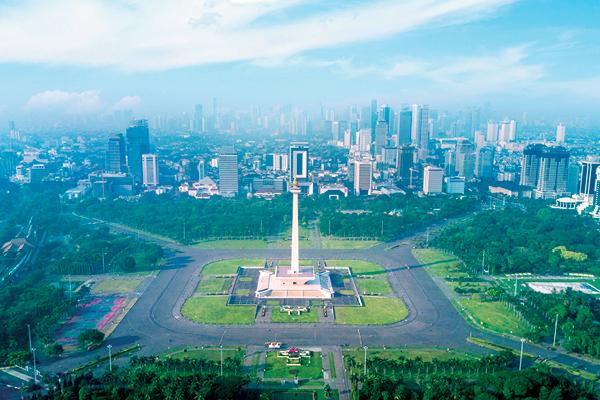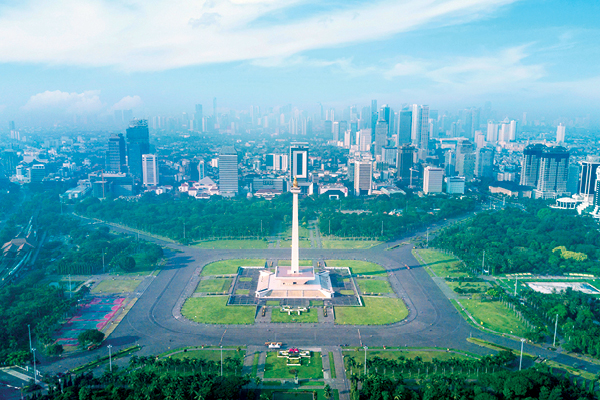
As China rolls out its massively ambitious Belt and Road Initiative across the region, Indonesia is set to be a key beneficiary. Lawyers discuss the work they are seeing as a result, and what the future holds.
There is no doubting the vastness of China’s Belt and Road Initiative (BRI), or its staggering ambition. A development campaign through which China wants to boost trade and stimulate economic growth across Asia and beyond, the BRI will build massive amounts of infrastructure connecting the Middle Kingdom to countries around the globe. By some estimates, China plans to pump $150 billion into such projects each year, and according to a report released by ratings agency Fitch last year, an incredible $900 billion in projects were planned or underway.
Indonesia stands to be one of the biggest beneficiaries of the BRI, with some $87 billion of investment set to make its way into the country, according to a 2016 report from Baker McKenzie. In April this year, Indonesian president Joko “Jokowi” Widodo came away from Beijing with five cooperation contracts worth $23.3 billion under the BRI, according to the Antara news agency. These included the construction of a $2 billion hydropower plant in Kayan in North Kalimantan, the construction of a $17.8 billion hydropower plant on the Kayan River and the development of a $1.6 billion power plant in Bali.
“China has been a major investor in Indonesia for several decades now,” says Norman Bissett, foreign legal consultant at Hadiputranto, Hadinoto & Partners, Baker McKenzie’s member firm in Indonesia. “More recent investments have focused on Indonesia’s infrastructure and transportation requirements, with combined Chinese and Hong Kong investments into Indonesia increasing last year by 12 percent to $5.2 billion, or slightly less than 20 percent of Indonesia’s realized foreign investment.”
He adds that one of the factors playing to the growth of Chinese investment into Indonesia has been BRI. “This looks likely to continue, with the Indonesian government paying active lip service, at least, to encouraging Chinese investment across a range of sectors, from major new tourism hubs, to agribusiness, smelters, power stations and transportation infrastructure development,” Bissett says. “With the largest population in Southeast Asia, a rapidly increasing middle class, and significant infrastructure requirements, Indonesia remains a prime destination for continued BRI investments.”
As a result of these projects and more, lawyers in Indonesia are seeing an uptick in work related to the BRI. “BRI’s focus on encouraging greater links through trade is apparent in the various assignments in which our firm has been engaged - most noticeably, in the development of high-speed railway infrastructure, and in Chinese investments into Indonesia’s power sector,” Bissett says. “The latter are primarily through M&A investment in completed projects.”
Genio Atyanto, partner at Nasoetion & Atyanto (N&A) agrees. “We have been experiencing an increase in foreign direct investment work since 2014,” he says. “We have also seen that infrastructure and energy-related transactions are increasing. However, those are not just because of the introduction of BRI by China alone. President Jokowi’s development programs have the same direction to improve the connectivity in this archipelago.” Adds Fabian Buddy Pascoal, a partner with Hanafiah Ponggawa & Partners (HPRP): “Opportunities have opened up for law firms in Indonesia and China to get involved in assisting investments and project deployments.”
GOVERNMENT HELP
Lawyers point out that the Indonesian government has taken a number of key steps in the recent past to improve climate, and this, in turn, has helped to increase the flow of Chinese investment into the country. “For the energy sector, the Ministry of Energy and Mineral Resources [MEMR] has announced its plan to revoke 32 energy regulations: 11 regulations from the oil and gas sector, seven regulations from the mineral and coal sector, seven regulations from the renewable energy sector, four regulations from the electricity sector, and three regulations from SKK Migas, the special taskforce for upstream oil and gas business activity,” say Miriam Andreta, partner, and Luky Walalangi, managing partner, of Walalangi & Partners. “In addition, to simplify the various regulations, the MEMR has announced its proposal to consolidate 51 energy regulations into 29 regulations.”
Multiple lawyers also highlight the impact of Government Regulation 24 of 2018 concerning Electronically Integrated Business Licensing Service. “GR 24/2018 introduces the so-called Online Single Submission [OSS ] system for issuance of licenses and permits by the government which may replace the earlier Investment Coordinating Board [BKPM]-centralised FDI processing,” says Ayik Candrawulan Gunadi, a partner at Ali, Budiarjo, Nugroho, Reksodiputro (ABNR). “The objective of this GR 24/2018 is to unify and simplify licensing process and government approvals nationwide. The OSS system will be a ‘single-reference’ online licensing system for the handling of licenses previously managed by different ministries and government agencies.”
Pascoal notes that the government is trying to make things easier for both Chinese and domestic investors when it comes to the BRI. “The government is also providing incentives such as tax holidays and other investment stimuli, and has proposed that certain provinces such as Bali, North Sumatera, North Kalimantan, and North Sulawesi be more open for BRI investments.”
Bissett elaborates on the fiscal incentives. “The Indonesian government also recently fiscal incentives for certain industries such as chemicals, metals and machinery in the form of tax holidays based on certain thresholds of investment amounts,” he says. “Investments greater than 30 trillion rupiah [$2.2 billion] and labour-intensive investments are entitled to ask for a 20-year tax holiday and an additional 50 percent tax cut for two years after the expiry of the tax holiday period.”
INVESTOR CHALLENGES
But despite all the good news, Indonesia can still be a challenging place to do business. “Land acquisition is still a major issue,” says Atyanto. “Conflicting regulations and policies between local and national government add another challenge to the investors. For more underdeveloped areas, although the project has potential revenues, the development costs may increase due to the lack of infrastructure or access to the surrounding areas.”
He adds that his firm always strives to bridge the gap between the investors’ plans and expectations, and Indonesia’s regulatory regime. “We maintain a good relationship with regulators, financial and tax advisors, as well as business players, and maintain the right contacts to seek for guidance on vague or conflicting regulations,” Atyanto says. “We believe those have been crucial in meeting the clients’ needs.”
Andreta and Walalangi say that from the regulatory perspective, the most challenging aspects are the various regulations in Indonesia spanning the central government to regional government regulations – which often overlap. “There is also inconsistency of government policies that may not be immediately apparent on the text of the written regulations,” she says. “However, as noted above, we have seen great efforts from the Indonesian government to overcome the issues. Close communications and regular discussions with the relevant government agencies on their respective policies and upcoming regulations are some of the ways we assist the clients in compliance and help them to foresee and assess potential legal risks.”
Gunadi points out two issues: lack of public trust and the bureaucracy. “There is a lack of trust from some sectors of the Indonesian public regarding general foreign investment in Indonesia, and, in particular, a closer economic relationship with China, due to the perception that foreign companies violate Indonesian laws and don’t benefit local communities, such as employing local workers,” he says. “Our firm has been assisting with FDI public trust issues by ensuring that our clients are aware of all national and regional regulations regarding foreign company requirements and adhere to other local-based regulations such as employing the required ratio of local workers, and advising on the transfer of skills from foreign to local employees.” Indonesia’s bureaucratic requirements can be complex, inefficient and costly, acting as a disincentive for, particularly new, foreign investors to engage the market, Gunadi adds.
Bissett says that the old days of assuming that Chinese investors would be willing to invest in “white elephants” when nobody else was, have well and truly disappeared, assuming they ever existed. “Although the BRI’s focus on projects being able to pay their own way, and generating ‘proper’ rates of return, means that such projects face much the same issues as any other project financed infrastructure developments, BRI projects do face some specific challenges,” he notes. “These include lengthy and cumbersome land acquisition processes, which sometimes come as a surprise to investors more used to command economies, and strong local employment protection rules, resulting on strict limitations on the use of foreign manpower. Other key issues revolve around identifying local partners, able to access the large capital amounts required (even with BRI financing), a lack of bankable ‘big’ projects, and the need to engage with (and win the hearts and minds of) local communities. Of major concern, in recent projects, has been the government’s insistence that it will not provide project guarantees.”
He says that challenges can be exacerbated if there is a misalignment of expectation on both sides. “While Chinese investors are more than able to manage risk, there is still sometimes an expectation that assurances given, at a senior level, will be sufficient to translate into positive action on the ground,” says Bissett.
POSITIVE PROSPECTS
Pascoal of HPRP says that the growing Chinese investment into Indonesia from 2012 to 2017 should continue. “We also see that the BRI is also in-line with the strategic framework in Joko Widodo’s administration,” he says. “The government of Indonesia has many infrastructure development projects which involve Chinese investors. As such, I can be sure that the BRI will bring significant benefits to both countries, Indonesia and China.”
If President Jokowi is re-elected in 2019, it is more likely that the transportation, infrastructure and energy projects are further developed in Indonesia in the next five to six years,” says Atyanto. “However, if the majority of the Indonesian no longer support and vote for President Jokowi in the general election, the directions of the development in Indonesia may change including whether Indonesia will still prioritize the sectors which support BRI.”
Walalangi and Andreta of Walalangi & Partners agree. “Judging from the positive approach taken by the government in acknowledging the complicated bureaucratic issues and overlapping regulations in Indonesia and seeing the government’s great efforts and willingness to overcome the issues, we are optimist with the outcome and result, which would lead to a steady development of Indonesian market, particularly given the attractiveness of Indonesian population to the international market,” they say.
Bissett feels that Indonesia will continue to be a key focus for BRI initiatives, but this will require a degree of realism, on the part of the government, to try to ensure that the investment regime continues to be open and welcoming to foreign investors. “This coming election year may test this, to some degree,” he notes. “Longer term, given the importance of Indonesia in ASEAN, we believe that Indonesia will be well placed to benefit from BRI investments. Key areas where we see growth opportunities are in renewables, transportation – including airports and ports – and industrial hubs based around existing infrastructure.”
To contact the editorial team, please email ALBEditor@thomsonreuters.com.
